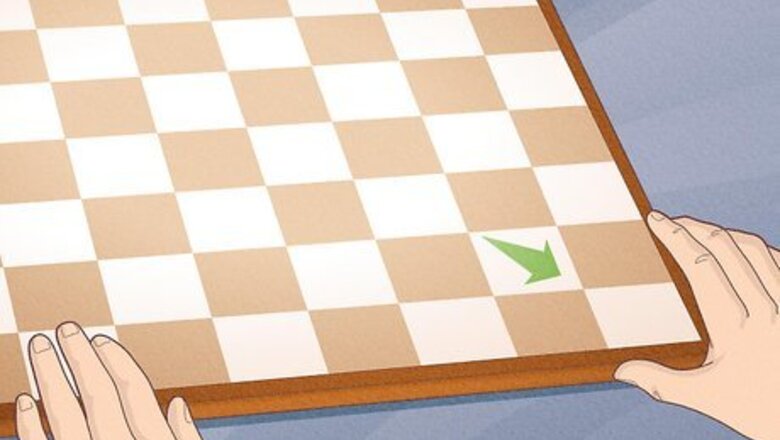
views
- Chess is a 2-player game where one player controls the white pieces and the other controls the black pieces.
- Each type of piece moves in its own unique way on the board. Use these different movements to craft your strategy to win.
- To win at chess, capture your opponent's king by trapping it so that it can't move away from your pieces to safety.
- Alternate turns with the other player, moving one piece at a time.
Setup and Rules
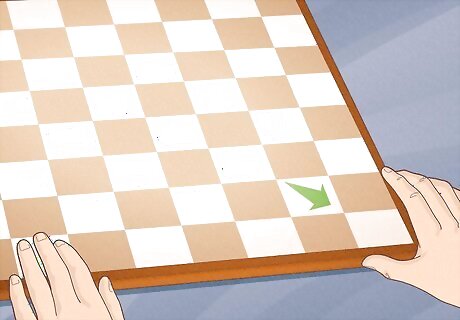
Set up the chess board with a white square in the bottom right-hand corner. The easiest way to remember this is with the phrase "white to the right." If your board has numbers down the side, the line ("rank") with a 1 next to it goes on the side where you'll line up the white pieces.
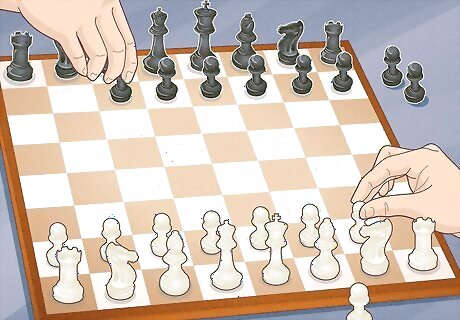
Arrange the pieces on the board as shown above. Start the game with all of the pieces facing each other on the back 2 rows of each side. Put the pawns in front, then line up the other pieces symmetrically with the king and queen in the middle. The king is the most important piece because the game ends if it's captured.

Learn how each type of piece moves. Each player controls 16 pieces: 8 pawns, 2 bishops, 2 knights (little horse heads), 2 rooks (little castle towers), 1 king, and 1 queen. Each type has its own way of moving across the board and potentially capturing your opponent's pieces as it goes. Pawns: Move 1 square forward per turn, except on their first turn, when they can move forward 2 squares. Pawns capture other pieces diagonally, moving one space diagonally forward. They cannot move backward. Rooks: Go as many squares as possible horizontally or vertically. If one of your pieces is in the way, the rook has to stop at the square just before. If one of your opponent's pieces is in the way, capture it with your rook and stop there. Knights: Move 2 squares horizontally or vertically, then 1 square to the right or left of that second square. Knights are the only pieces that jump over other pieces and only capture an opponent's piece if it's on the final square of the move. Bishops: Go as many squares as possible diagonally. Like the rook, they have to stop at the square just before one of your own pieces, or capture an opponent's piece and stop there. King: Move 1 square in any direction. You cannot move the king into any space where one of your opponent's pieces could capture it. Queen: Go as many squares as possible in any direction. Like the rooks and bishops, the queen has to stop just before one of your own pieces, or capture an opponent's piece and stop there.

Take note of the special moves that pawns, rooks, and kings can make. These moves aren't anything you really need to worry about during your first few games, but you want to at least know they exist. As your play advances and you get more comfortable, you'll find that you use them more and more. Pawns: If your opponent moves a pawn 2 spaces on its first move so that it's sitting right next to one of your pawns, you can capture it with your pawn on your next move—but only on your next move. This special ability is known as en passant (French for "in passing"). Pawns: If a pawn makes it all the way to the back row of the other side of the board, it gets promoted. That means you can turn that pawn into any type of piece other than a king. Most players promote a pawn to a queen because the queen is the most powerful piece. Kings and rooks: When there are no pieces between your rook and your king on the back row, you can move your king 2 spaces toward your rook. Then, immediately move your rook over to the other side of your king. This is called castling.
Gameplay

Start the game off if you have the white pieces. In chess, the player with the white pieces always makes the first move. You and your opponent might want to flip a coin to see who gets the white pieces, since they do have a slight advantage (mainly, that with white you get to attack first).
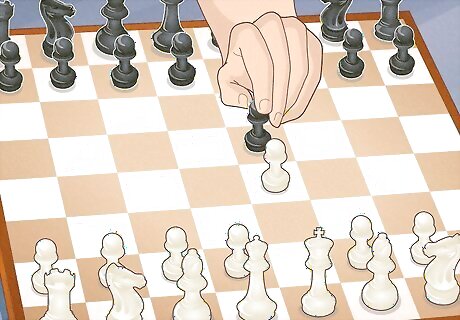
Take turns with your opponent to move one piece. Chess flows just like any other turn-based board game, with each player getting the opportunity to move one piece before the action switches back over to their opponent. When thinking about what move you want to make, consider the different moves that all the pieces on the board can make. There's no "pass" in chess—when it's your turn, you have to move something.
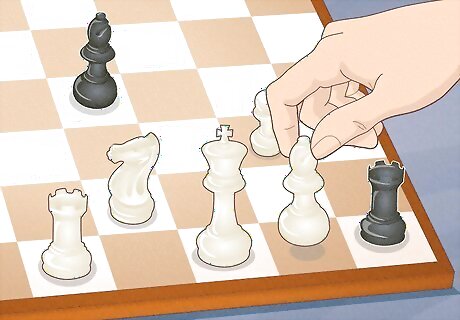
Block, evade, or capture to get your king out of check. As the game progresses, at some point, your opponent is likely to put your king in check (or perhaps you'll put their king in check). This just means that if nothing changes, your opponent would capture your king on their next move. When your opponent announces "check," you must do something to get out of check. You have 3 basic options: Block: Move one of your pieces in between the attacking piece and your king. Evade: Shuffle your king over one square so he's out of the attacking piece's line of attack. Capture: Use another piece to capture the piece your opponent is attacking with. Threat eliminated—whew!
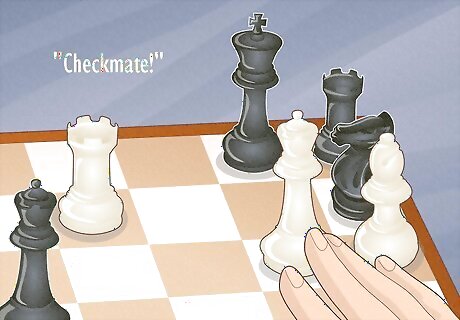
Continue to play until one player's king is captured or there are no legal moves. And that's the game! Your goal is to checkmate your opponent and protect your king so your opponent can't checkmate you. Sounds simple, right? But with so many pieces in play, the strategy and planning can get quite complex. Since you're just starting out, focus on always protecting your king and you'll do fine. Sometimes you play to a stalemate—that's sort of the opposite of checkmate when neither of you has any legal moves left. This usually happens when most of the pieces have been captured. When you're playing in a tournament, there are a few other ways a game can end, such as if you run out of time. But as a beginner, you don't need to worry about those yet.
Strategy
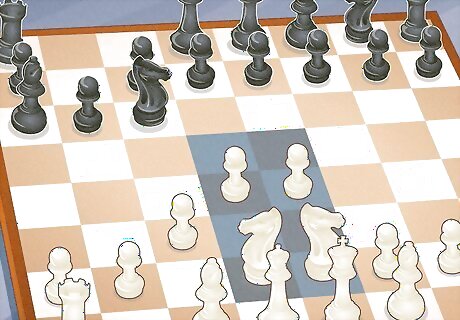
Control the center of the board as quickly as possible. This gives you the upper hand and allows you to craft attacks while also defending against your opponent's attacks. When you control the center of the board, you maximize your ability to move while also limiting your opponent's ability to move without being captured. For example, a knight in a corner only has 2 options to move, but from a central square, it has as many as 8 options. Getting the center pawns a couple of spaces out in the first couple of moves of the game gives you a good head-start toward controlling the middle of the board.
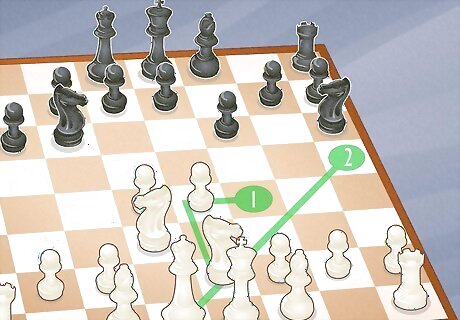
Try to think a move or two ahead. Chess isn't a game that you can play one turn at a time. Consider all of the pieces and their possible moves, then make your move based on what might happen a move or two down the road (seasoned chess players call this "calculating"). This takes a lot of practice, so don't worry if you can't do it at first. Do this by thinking through a series of "if...then" statements. For example, you might think, "If I move my knight here, then it will threaten my opponent's bishop, so they'll probably move their bishop there. If they move their bishop there, then they could put my king in check."

Protect your king. If your opponent puts your king in checkmate, that's the end of the game, so you want to protect your king at all costs. At the start of every turn, evaluate your king's position and where it might be vulnerable. As a beginner, it's always better to take a move to shore up your king's defenses than to attack. Watch the pieces your opponent moves off the back row (this is called "developing" your pieces). Any of them could potentially be used in an attack, so project them forward a few moves ahead to see if they're a threat.
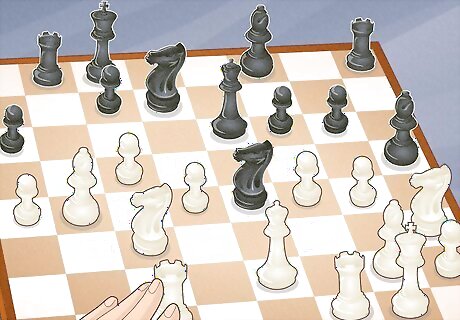
Get all of your pieces involved in the game. None of your pieces are powerful at all if they just sit on the back row and do nothing. While you don't necessarily want to develop your queen too early in the game, your other pieces can definitely come forward to build a powerful defense and lay the groundwork for future attacks. This also keeps the board active and lively—your opponent will be on the alert trying to figure out what you're doing. Think about leaving space open for your queen to enter later. When you do develop your queen, you want to be able to maximize her power and use her to her fullest potential.
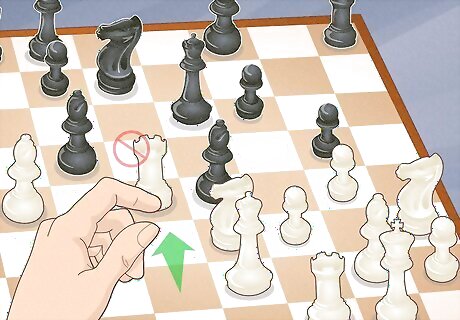
Avoid sacrificing pieces unnecessarily. There's nothing wrong with a sacrifice play from time to time, but try to keep them to a minimum. A piece lost can't be regained, and if you get too far down you'll have a hard time defending against a multi-pronged attack from your opponent. Obviously, any sacrifice is worth it to protect your king. But before you put one of your other pieces in the line of fire, make sure there's no other option that doesn't involve losing a piece.
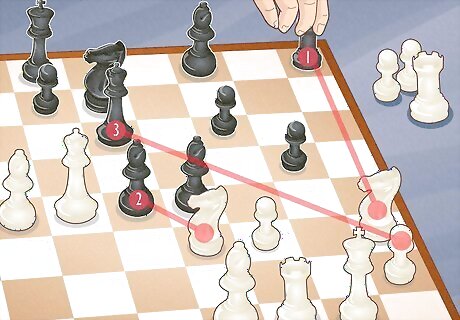
Try to get into your opponent's head to figure out their strategy. Every time your opponent makes a move, ask yourself why they made that move. If you can figure out what they're trying to do, you might be able to do something to disrupt their plans—or at least make them more difficult to pull off. When you're just learning how to play, don't be afraid to ask—especially if you're playing someone more experienced. They might not want to talk to you about it during the game, but afterward, they can help you with moves you didn't understand.










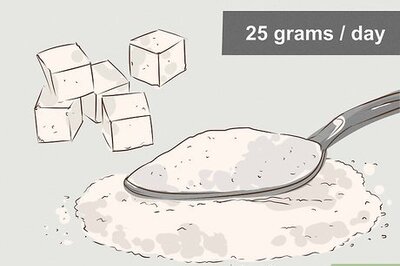


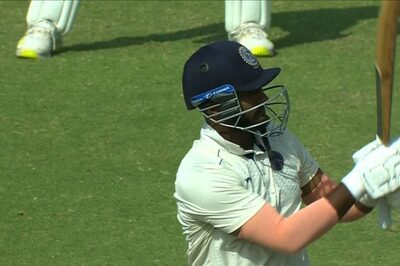

Comments
0 comment